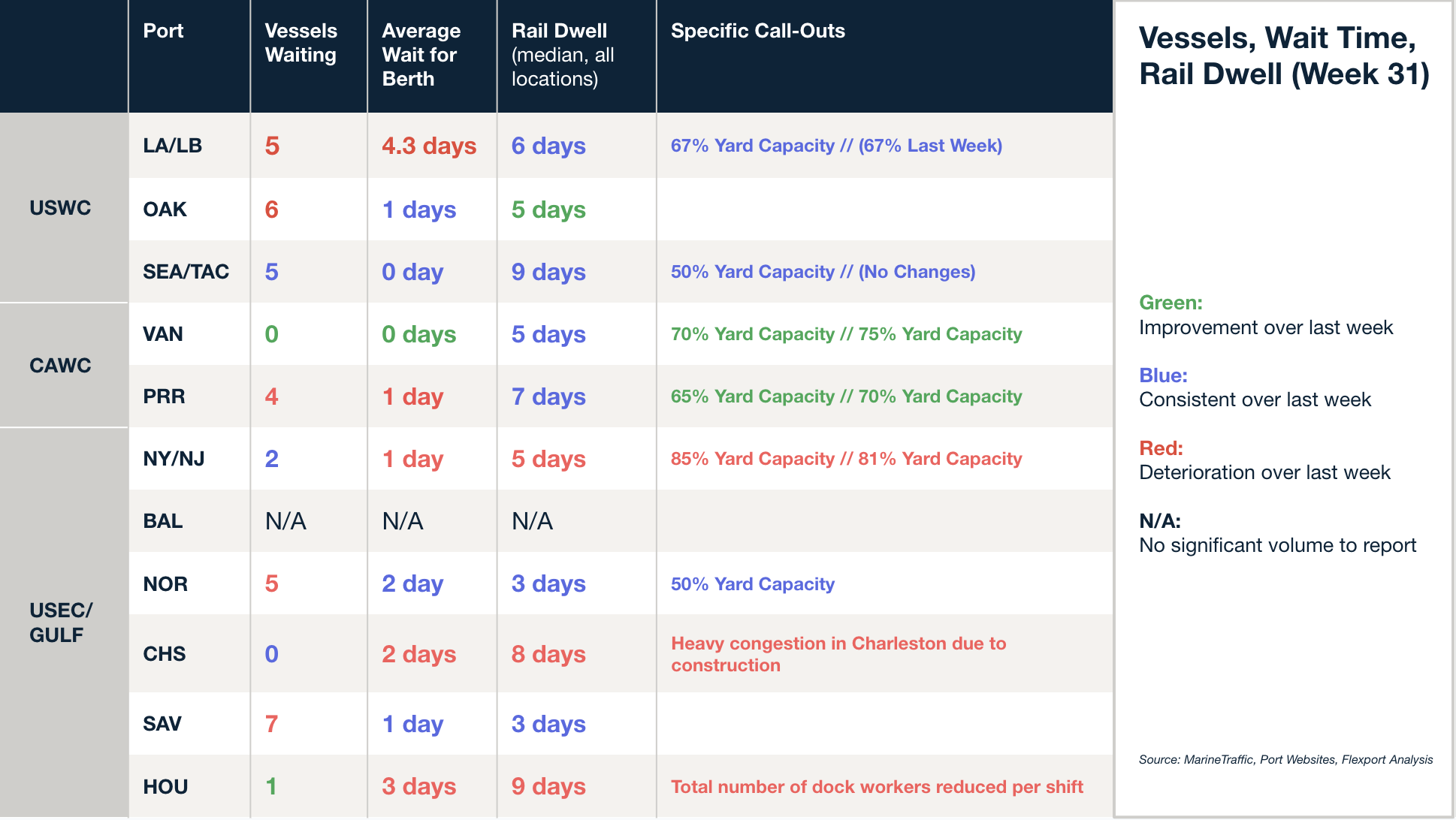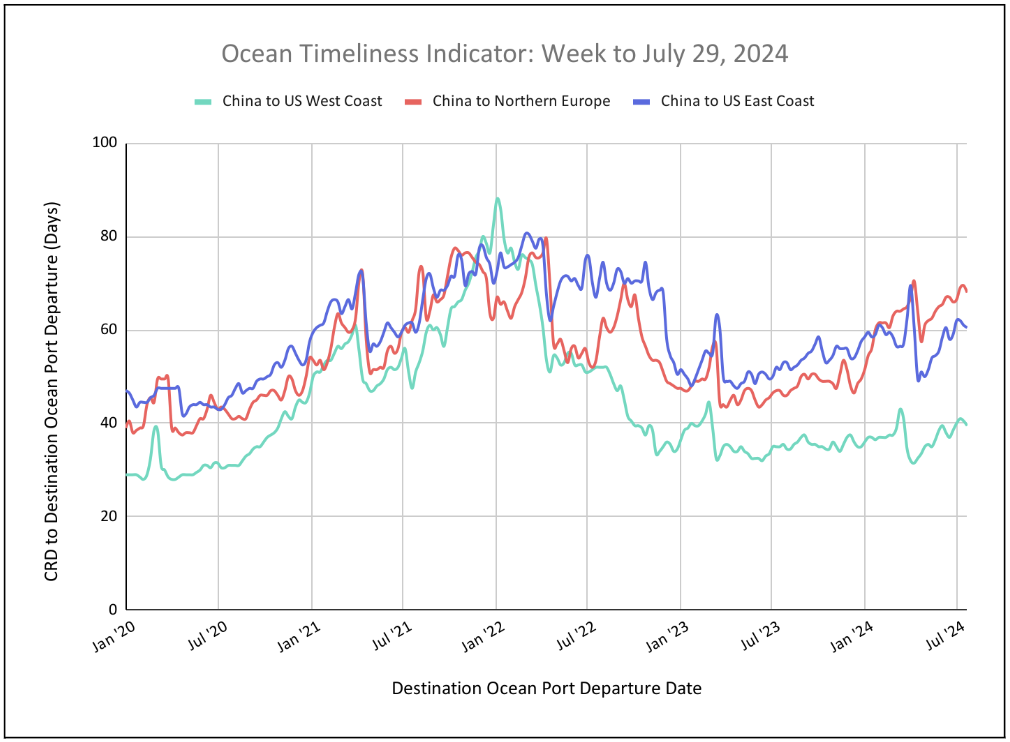Trends to Watch
[Ocean – TPEB]
- Volumes remain strong, exceeding last year’s numbers on Transpacific routes. We’re seeing structurally blank sailings due to Cape of Good Hope (COGH) routings and port congestion in Asia and North America. Due to bad weather conditions around the COGH, please expect further delays and capacity challenges en route to the U.S. East Coast (EC). Since extra loader (XL) space was injected into the Transpacific trade lane, we’ve seen less space pressure on the U.S. West Coast (WC), specifically the Pacific Southwest (PSW), from China’s main ports.
- Floating rates: Shipping lines have started to reduce rates for the EC and WC to match supply and demand. We’ve seen shipping lines try to stabilize rates for the second half of August by introducing an early General Rate Increase (GRI) announcement.
- Fixed rates: Peak Season Surcharge (PSS) discussions are very intense at the moment, as the gap between FAK rates and NAC rates do not support mitigations, specifically in light of a potential GRI in August.
[Ocean – FEWB]
- Port congestion in Asia is improving, but overall on-time performance for Asia-Europe trade remains suboptimal due to reroutings via the Cape of Good Hope. Blank sailings will continue in August. A few extra loaders have been injected into the FEWB to compensate for downsized vessels, and to maintain schedule reliability.
- Demand is strong, and floating rates remain on the higher end. The Shanghai Containerized Freight Index (SCFI) dropped slightly over the past two weeks. With blank sailings in place, we’re expecting the floating market to remain critical.
- Long-term named account space remains limited and restricted by carriers for space and equipment priority.
- Equipment shortages have improved a bit since May and June. For some Port of Loadings (POLs) with less direct calling, we still foresee potential equipment shortages for certain container types, such as 20’GPs.
- Port congestion in Netherlands/Belgium, coupled with on-and-off strikes in Germany and France, has impacted terminal operations and last-mile deliveries. We recommend closely monitoring container movements.
- For urgent cargo with a target delivery date, we recommend selecting premium options as early as possible for an earlier estimated time of departure (ETD) and space with higher equipment priority.
[Ocean – TAWB]
- North Europe: Carriers have begun noticing the effects of reduced capacity due to full vessels. Demand remains stable, and some factories on the Northwest of the continent are closed for the months of July and August.
- Congestion in the Mediterranean region remains, with an average wait time of 4-7 days outside of the main ports of Italy and Spain. Also, strikes at ports in Southern Italy have exerted more pressure on certain services. The effects are now being felt in the East Mediterranean, where rates are increasing.
- North Europe: Yang Ming Line announced a GRI for the 1st of September. Mediterranean Shipping Company and Ocean Network Express are considering applying for a PSS in September. The intention is to stop rate deterioration.
- Mediterranean: Carriers already increased their rates for August. No news about new increases in September.
- We expect to see signs of the usual slack season in August starting next week.
[Ocean U.S. Exports]
- Capacity from the Southeastern U.S. has tightened routes to the Indian subcontinent, Middle Eastern ports, and North European ports, amid vessel omissions and blank sailings.
- Service strings relying on feeder services to final Port of Discharge (POD) are losing capacity as appropriate vessels are being shifted to headhaul trades and congestion continues to deteriorate the repeat serviceability of the feeder lane.
- Challenges related to earliest return dates (ERDs) continue to persist for U.S. exporters.
- To ensure the smoothest loading experience, we recommend booking two weeks in advance for bookings loading at a coastal port, and 3-4+ weeks in advance for bookings loading at an inland rail point.
[Indian Subcontinent to North America Update]
- Rates continue to increase due to capacity constraints. Structural and unexpected blank sailings, increased transit time around the COGH, and rising demand have caused freight rates to surge into 2H July. Rates are expected to continue climbing into August, as yet-to-deploy capacity faces delays around the COGH.
- Large rollover pools have added further stress to upcoming sailings. Due to changing vessel sizes and an over-acceptance of bookings on each vessel, ocean carriers are being forced to roll cargo onto the next available sailing—not only delaying your shipments, but also taking away capacity for net-new bookings. As a result, some carriers have temporarily paused bookings to normalize loadings.
- These impacts are being felt differently across service providers, with many smaller providers being forced to use spot market booking platforms. (This means that their allotted space has been removed from the vessel plan in the short term.) These freight providers will now have to pay the market rate of over $10,000 per 40-foot container to obtain space.
- New India America Express (INDAMEX) services are expected to bring relief. Both HPL and CMA are launching their own standalone services to support Northwest India and Pakistan. These services will also temporarily support Colombo loadings on the first few sailings to clear accumulated backlogs in Sri Lanka. We can expect space to open up as these carriers, including their co-loaders OOCL and COSCO, will now have greater capacity than in 2023.
- India port issues: Two top ports, Nhava Sheva and Mundra, are facing terminal congestion issues due to heavy rainfall in Mundra, increased volume, and sliding/bunched sailing schedules. Carriers have resorted to early vessel gate closures to properly manage yard utilization and vessel loadings.
- Bangladesh backlog: Due to political protests in Bangladesh, there is a substantial backlog accumulating in the country. Vessels continue to work through this backlog, which is expected to further exacerbate ongoing congestion issues in Colombo, Sri Lanka. This is because over 50% of all cargo coming out of Bangladesh requires a transhipment in Colombo.
[Air – Global] (Source: WorldACD)
- Global rate increases amid declining tonnages: Average global air cargo rates rose by +2% in the third week of July 2024 to $2.56 per kilo, despite a third consecutive week of worldwide tonnage declines. This rate is +14% higher than the same week last year, and +47% higher than pre-COVID levels in July 2019.
- Asia-Pacific rate surge: Spot rates from Asian-Pacific origins increased by +2% to $3.34 per kilo in week 29 (July 15-21), marking a +25% increase compared to the same week last year. The rate hike was driven by a +2% rise in average prices, despite a -2% week-on-week tonnage drop.
- Demand and rate dynamics to the U.S.: Rates from the Asia-Pacific to the U.S. increased by +5% in week 29, with average spot prices exceeding $6 per kilo ($6.01), a +67% YoY rise. Chargeable weight from the Asia-Pacific to the U.S. rose by +2% WoW and +8% YoY, although tonnages from China to the U.S. fell by -8% YoY.
- MESA to Europe trends: Demand from MESA origins to Europe, while still +15% higher than the same period last year, has cooled from the +30% to +50% levels we saw earlier in the year. Average spot rates from MESA to Europe in week 29 were $3.30 per kilo—more than double (+126%) their levels last year, with significant increases from Bangladesh (+178%), India (+161%), and Sri Lanka (+78%).
Please reach out to your account representative for details on any impacts to your shipments.
North America Vessel Dwell Times

Flexport Ocean Timeliness Indicator
Ocean Timeliness Indicators exhibit a downward trend for China to the U.S. West Coast, China to Europe, and China to the U.S. East Coast.
Week to July 29, 2024
This week, the Ocean Timeliness Indicator for China to the U.S. East Coast and China to the U.S. West Coast have decreased, falling from 61 to 60.5 days and 40.5 to 39.5 days, respectively. The OTI for China to Northern Europe also decreased, dropping from 69.5 days to 68 days. The reason? Port congestion on all trade lanes is slightly improving.

Source from Flexport.com
